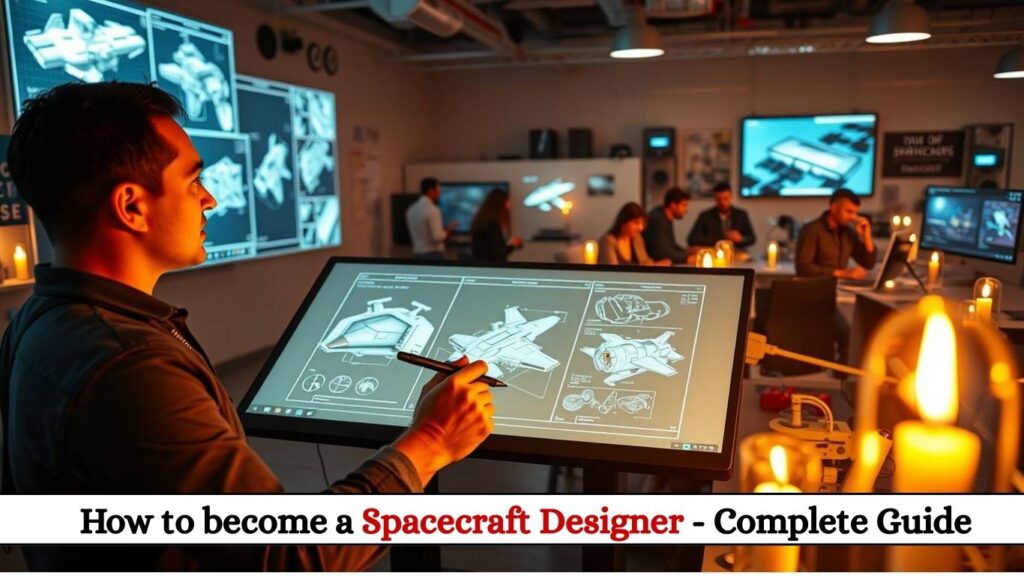
Introduction: The Architects of Space Exploration
Spacecraft designers are the visionary engineers who transform concepts into functional vehicles capable of surviving the extreme conditions of space. From interplanetary probes to crewed Mars landers, these professionals combine cutting-edge engineering with creative problem-solving to push the boundaries of space technology.
This ultimate guide covers:
- Evolution of spacecraft design from Sputnik to Starship
- Salary ranges across government and private sector
- Specialized roles and daily responsibilities
- Educational pathways and must-have skills
- Step-by-step career roadmap
- Future technologies shaping the industry
- Top companies hiring designers
Whether you’re an engineering student or considering a career change, this guide will help you navigate your journey to designing humanity’s next generation of spacecraft.
History of Spacecraft Design
Pioneering Era (1950s-1970s)
- 1957: Sputnik’s simple spherical design sets baseline
- 1961: Vostok capsule’s human-rating challenges
- 1969: Apollo program’s lunar module innovations
Shuttle Generation (1980s-2000s)
- 1981: Space Shuttle’s reusable orbiter concept
- 1998: ISS modular design philosophy
- 2004: SpaceX’s Falcon 1 introduces modern commercial design
New Space Revolution (2010-Present)
- 2015: Crew Dragon’s 3D-printed components
- 2020: Starship’s stainless steel construction
- 2023: Lunar Gateway’s international design collaboration
Spacecraft Designer Salaries (2024)
| Position | Entry-Level | Mid-Career | Senior-Level |
|---|---|---|---|
| Structural Designer | $82,000 | $120,000 | $160,000+ |
| Propulsion Systems | $90,000 | $135,000 | $185,000+ |
| Thermal Protection | $85,000 | $125,000 | $170,000+ |
| Chief Designer | N/A | $150,000 | $250,000+ |
Industry Variations:
- NASA/ESA: $75k-$160k (strong benefits)
- SpaceX/Blue Origin: $90k-$200k (stock options)
- Defense Contractors: $110k-$230k (security clearance premium)
Roles & Specializations
1. Configuration Designers
- Establish vehicle architecture
- Balance mass vs. performance
- Coordinate subsystem integration
2. Structural Engineers
- Analyze launch/landing loads
- Select materials (composites, alloys)
- Optimize for micrometeoroid protection
3. Thermal Systems
- Design heat shields
- Develop active cooling systems
- Model orbital thermal cycling
4. Propulsion Integration
- Engine placement optimization
- Fuel tank structural design
- Thrust vector control systems
5. Human Factors
- Crew cabin ergonomics
- Life support integration
- Emergency egress design
Essential Qualifications
Education Requirements
- Bachelor’s Degree in:
- Aerospace Engineering
- Mechanical Engineering
- Materials Science
- Advanced Degrees Preferred:
- MS in Space Systems Design
- Ph.D. in Hypersonics
Technical Skills
✔ CAD (CATIA, NX, SolidWorks)
✔ FEA Software (ANSYS, NASTRAN)
✔ Systems Engineering (MBSE)
✔ Programming (Python, MATLAB)
✔ GD&T (Geometric Dimensioning)
Certifications
- INCOSE Certified Systems Engineer
- NASA’s Systems Engineering Leadership Program
- Additive Manufacturing Certifications
Career Roadmap
Phase 1: Education (Years 1-4)
- Pursue aerospace engineering degree
- Join Formula SAE or Rocketry teams
- Complete NASA internships
Phase 2: Early Career (Years 5-8)
- Start as design analyst
- Specialize in subsystem design
- Earn professional engineer license
Phase 3: Advanced (Years 9-15)
- Lead design teams
- Obtain security clearance (for defense work)
- Present at conferences (AIAA, IAC)
Phase 4: Executive (15+ Years)
- Become chief engineer
- Establish design standards
- Consult on next-gen concepts
Future Technologies
Emerging Design Paradigms
- Autonomous Assembly: Robots building spacecraft in orbit
- Biomimicry: Bio-inspired structures
- Nuclear Thermal: Compact propulsion systems
Growth Areas
🚀 Artemis Lunar Landers
🚀 Mars Transit Vehicles
🚀 Orbital Manufacturing Stations
Top Employers
- SpaceX (Starship development)
- Blue Origin (Blue Moon lander)
- Sierra Space (Dream Chaser)
- NASA Centers (Langley, JPL)
- ESA (Ariane & Exploration)
Conclusion: Designing Humanity’s Future in Space
Spacecraft design offers unparalleled opportunities to create technologies that will define our interplanetary future. With commercial space spending projected to reach $1.4 trillion by 2030 (Morgan Stanley), demand for skilled designers will continue growing exponentially.
Key Action Items:
- Master both classical and digital engineering tools
- Develop systems thinking beyond your specialization
- Build a portfolio of design projects
- Stay current with materials science breakthroughs
The spacecraft you design may carry the first humans to Mars or discover life in Europa’s oceans. Are you ready to put your mark on the future of space exploration?
This guide combines industry insights, technical details, and career strategy while optimizing for search visibility. Would you like me to emphasize any particular aspect of spacecraft design?













Post Comment